Varieties and cultivation of floribunda roses
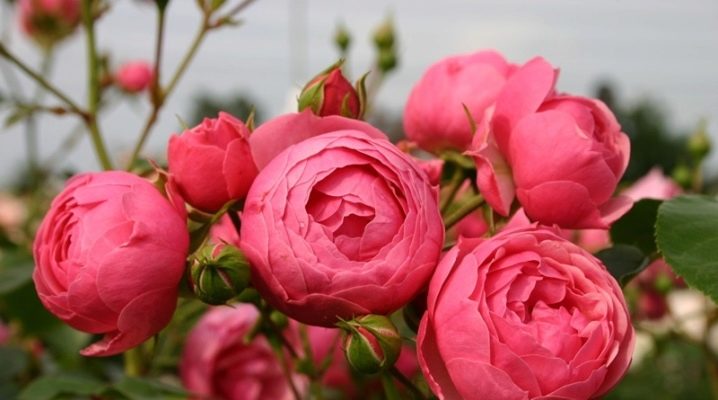
Regardless of the variety, any rose can become a garden decoration, since as a flower it is unpretentious, does not require much attention to itself, but at the same time pleases with incredible beauty and a variety of colors. Floribunda roses are one of the most popular varieties because they are resistant to temperature extremes, disease and pest resistance.
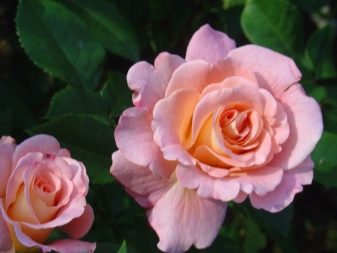
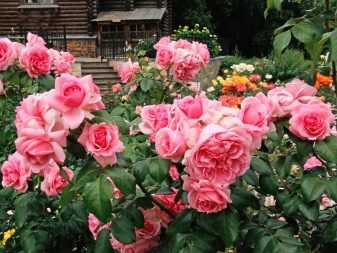
What it is?
Floribunda roses are a hybrid of tea and wild roses, also known as polyanthus. The garden flower is mainly grown for decorative purposes in private gardens. Flowers appear on small but very dense shrubs that have thick stems. During the period of abundant flowering, inflorescences appear at the end of the stem.
Hybrid tea roses, which were taken as the basis of this species, have been cultivated for many years., so that more double flowers or single flowers, but collected in small groups, begin to appear on the bush. This species is characterized by a long flowering period. Some varieties exhibit large bushes, others are compact, ideal for confined spaces.
Floribundas differ from them in that they show flowers in large, dense clusters with a large number of ovaries. All open at the same time in each inflorescence. From a technical point of view, the floribunda flowers are less perfect than the hybrid tea, and can be single, semi-double or double. Moreover, they are less scented.
However, their advantage is that such roses are more tolerant of negative environmental factors. They produce more flowers and continue to bloom for a long period.
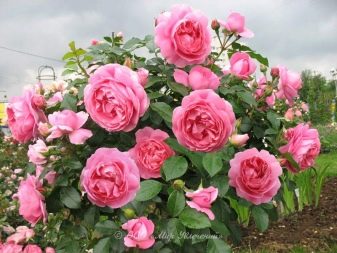
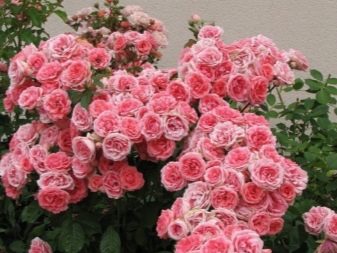
They can also be grown in large containers. Floribundas do not need a trellis.
The plant offers shades such as:
- pink;
- peach;
- Red;
- purple;
- Orange.
Some varieties of Floribunda roses can even be multi-colored. One example is the George Burns rose - yellow with red spots.


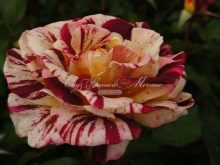
The foliage of most shrubs is light to dark green in color. The leaves are usually oval and somewhat pointed at the end. From a distance, it may seem that their upper part has a glossy finish. Thorns usually appear on the stem just above the leaves but below the flower.
Growers have no difficulty in growing floribunda roses. Plants should be watered frequently to keep the soil from drying out, add at least 5.08-7.62 cm of mulch to the ground around the bush to control soil temperature and prevent weeds. From time to time, pruning may be required to help the plant maintain its shape. Fertilizer can be added during the spring and summer months.
Many people choose to plant floribunda roses as an accent plant in a butterfly or bumblebee garden. Others place shrubs as a border around other flowers. They can be grown in large containers on patios or balconies. The versatility of these roses, along with a large variety, makes the plant in demand in any year.
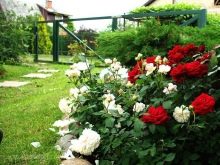
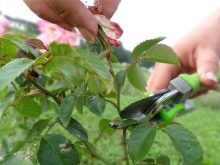

Varieties
- Leonardo da Vinci. Densely doubled variety with abundant and very dense foliage. It is characterized by abundant and long-lasting flowering. In the sun, bright saturated pink flowers do not fade, they are not afraid of abundant moisture.
- Augusta Louise. Will delight the gardener with large flowers that have an iridescent shade, depending on the ambient temperature.They can be wine or peach.
- "Niccolo Paganini". The red velvet rose is more common in warm climates. She pleases gardeners with abundant flowering, disease resistance. Great for decorating flower beds.
- "Kimono". First appeared forty years ago, the shade of flowers is salmon pink. Each inflorescence contains 20 flowers. It blooms very profusely, the bush turns out to be spreading, but it is prone to black spot.
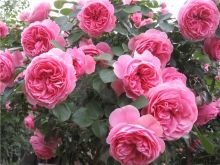
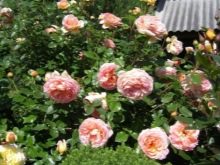
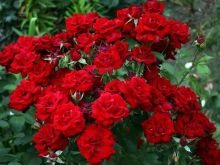
- "Pomponella". A rose for flower beds, which can be strongly extended upwards. Flowers have a dark pink color, they are collected in a brush of 7 pieces. The bushes of the plant are branched, but stand upright.
- "Bonika". It is popular with gardeners because it quickly takes root and grows, in addition, during the flowering period it is completely covered with flowers of a pale pink hue. The plant continues to delight with its beauty until late autumn.
- Midsummer. The bushes have medium-sized flowers, which are also densely double, with a red-orange tint. If we talk about endurance, then this is one of the most powerful plants.
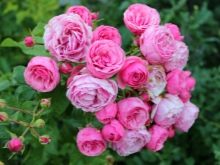

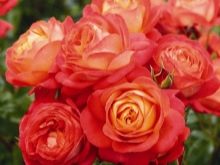
- "Samba". A rose variety that is speckled, the flowers themselves are reddish yellow. Even on a cloudy day, such bushes in a flower bed make the atmosphere festive. Being in the sun, the flowers do not fade, but only become brighter.
- The Brothers Grimm. The bushes of this rose are often used in flower beds in park areas, since the plant has good disease resistance and requires a minimum of attention. The flowers are bright orange, collected in large clusters. It is a densely doubled variety with dark green glossy foliage. The rose can grow up to 70 centimeters, the bushes are branched.
- Arthur Bell. Floribunda, which has gained particular popularity in regions with cold winters, because it can withstand frost without additional shelter and not die. The bright yellow flowers become more lemon-toned or even creamy over time. The petals are semi-double, in the middle are crimson stamens.

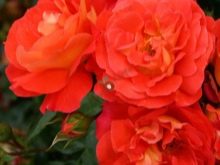
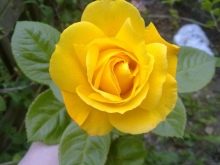
- "Geisha". A rose that is popular due to its large growth and spreading shoots. Apricot orange flowers are collected in attractive large inflorescences that appear in large numbers on the bush. On average, the height of a rose reaches 80 centimeters.
- "Angel's Face". The plant was bred in 1968. The rose has pointed buds. The flowers are quite large, have good doubleness, have lavender-lilac petals surrounded by golden stamens. Cup-shaped or flat, they are produced almost continuously throughout the season. The rose has a strong fruity aroma.
- "Apricot". This rose has been delighting gardeners since 1965. Flowers on bushes are cup-shaped, clusters of three or more buds. Their fruity (apricot) aroma is quite strong. The leaves are dark green, leathery and glossy. The bushes are fluffy, but compact.
- Betty Boop. They have been at the disposal of gardeners since 1938. This is one of the first floribunda hybrids. During this period, the rose has retained its popularity due to its fragrant aroma and bright pink flowers. Single buds have five petals.
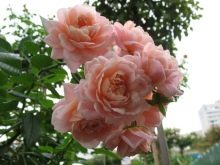
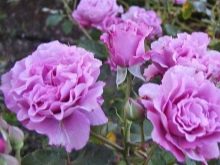
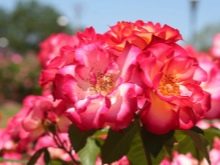
- "Brown Velvet". This is one of the few roses that has a unique brown color. On the buds, 35 petals are located across. The bushes emit a slight fragrance. The variety is popular due to its disease resistance.
- "The cathedral". Bred in 1975 as a gift for the anniversary of the restoration of Coventry Cathedral in England. The rose has high flowers ranging from dark apricot to orange, turning into a shade of yellow. The aroma is light but pleasant.
- "Chic". The long pointed buds grow into flowers of a pure, bright white tone. Each flower has 20 to 25 petals and emits a light fruity aroma. They can bloom both with free-standing buds and in inflorescences. The variety is winter-hardy.
- "Escapade". The bushes have simple pink flowers with a white spot in the center. The rose has an exceptional aroma, blooms profusely, is hardy. The plant is used for low hedges.
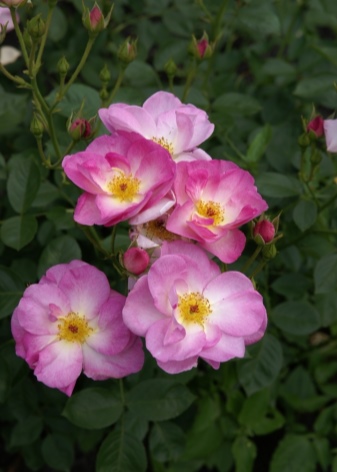

- "Evropeana". A plant whose buds are deep red in color without any impurities. It is used very often when creating bouquets. Can be planted in large quantities in flower beds. The rose is immune to fungal diseases, so they like to use it in flower beds in parks and squares.
- "Fashion". It has oval buds that turn into coral-peach flowers with 20-25 petals and a sweet aroma. The bushes bloom at the same time and delight with an abundance of color.
- "Lord of Fire". The variety was bred in 1959. Oval buds open and turn into inflorescences ranging from fiery scarlet to orange-red with 50 petals. The plant emits a musky aroma, the foliage is dark green and leathery. This rose has good winter hardiness, but is prone to mold.
- "First Edition". It boasts coral orange buds and the same flowers. The petals are surrounded by yellow stamens, the smell is light, sweet. Bushes are formed upright. This rose is great for creating bouquets.
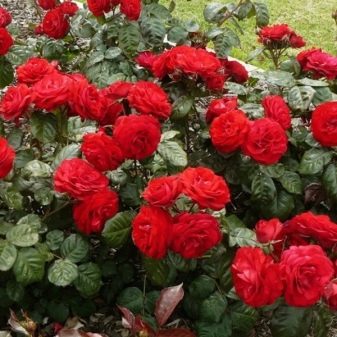
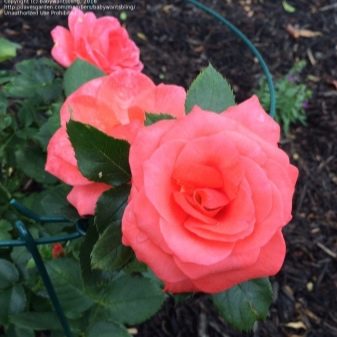
- "French Lace". A delicate rose that cannot withstand the cold. It is grown in milder climates. Flowers make a lasting impression. The shade is close to a pale apricot, sometimes creamy white, always in the elegant shape of a classic hybrid tea rose. Blooms until the end of autumn.
- Gene Berner. A floribunda classic that exhibits medium-sized pink flowers, quite dense, with 35 petals in bloom. The bushes are unusually tall and slender, which allows them to be used in a small space. The rose is exceptionally tolerant of heat and humidity.
- Gruss An Aachen. The buds of this plant are colored red-orange and yellow according to the description. During flowering, it is difficult not to notice the rich aroma. The leaves are green and dense. The rose is capable of blooming even in partial shade. It will be an excellent choice for creating a small hedge.
- Hannah Gordon. It has large double flowers, white with a pink border. Each flower has about 35 petals and a light scent. Blooms continuously throughout the season. The foliage is large. The bush is upright, compact.
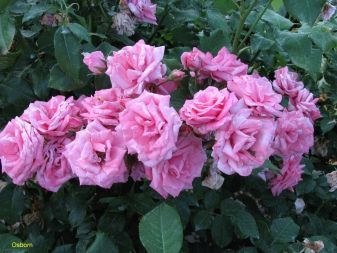

- "Iceberg". One of those very cold-tolerant roses. It can grow with equal success in the south. The flowers are double, pure white and very fragrant, kept in clusters above light green foliage. A great plant to create a winter hardy hedge that will continue to bloom from late spring to fall and even during the winter in the south.
- Impatient. The name of this variety suggested that the plant should have bloomed again immediately after the first cessation of flowering, but the interval turned out to be large. The slightly fragrant flowers have a bright orange hue with a yellow base. Each flower has 20 to 30 petals.
- "Independence". The brilliant orange-red flowers have a special contrast. They are very fragrant, stand out well against the background of foliage. Although flowering may be more intermittent than other floribundas, this rose shows good fertility. The plant was developed by the German scientist Wilhelm Cordes.
- "Intrigue". Truly intriguing flowers that have a plum hue. Very fragrant. The bushes have highly spreading stems, each bud has 20 petals. Dark green foliage covers the thorny trunks.
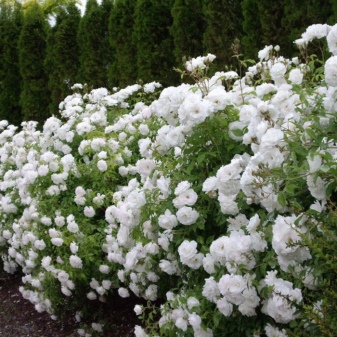
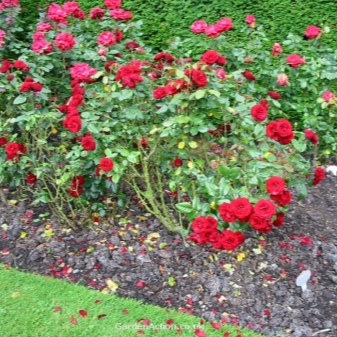
- "Ivory". The bush has creamy white roses during the flowering period, which begin with rounded yellow or peach-colored buds. The variety boasts a pleasant, but not sugary aroma.
- "Dove". The rose was bred in 1956. The flowers are a mixture of yellow and salmon pink. Bushes grow quite large and wide. It is a hardy variety with dark green foliage and requires regular pruning.
- "Ma Perkins". The plant creates a compact bush. For the first time this rose appeared on the market almost half a century ago. Its flowers are unusual for a floribunda: the shell is pink with the addition of a hint of apricot and cream. The flowers are fragrant, the foliage has a deep glossy green hue. The shrub has a compact shape, so a flowering hedge can be formed from it.
- Margaret Merrill. It has large fragrant flowers that seem to be covered with blush on a white background. In terms of the intensity of the scent, a rose can be compared to a perfume that would have slightly citrus notes with the addition of spices. The plant thrives in humid climates, although it is prone to black spot.
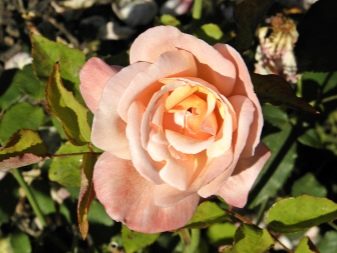
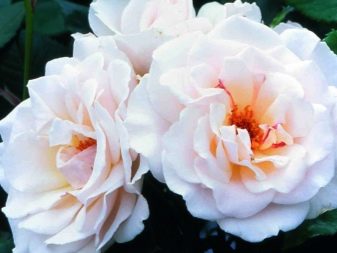
- "Marina". It is characterized by long, pointed buds that develop into large, bright orange-red flowers with a yellow base. They have 35 to 40 petals and a delicate aroma.
- "Matador". Flowers combine scarlet, orange with golden yellow hues. The smell is very light, pleasant. The bushes bloom for a long time, do not require special attention.
- "Orangeade". Slightly fragrant medium-sized flowers on the shrub have 12 to 15 petals. The color is very interesting, like a bright orange, accentuated by bright yellow stamens. The bushes have natural protection against mold, so they do not need to be specially treated.
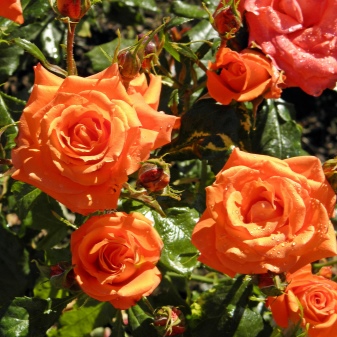
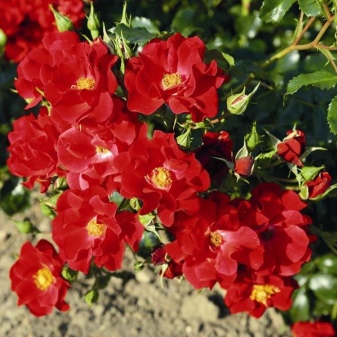
- "Playboy". It boasts burgundy-bronze buds, which subsequently form large flowers with up to 10 petals. They bloom until late autumn, the bushes look just gorgeous: bright inflorescences against a background of dark green leaves. This rose is disease resistant and tolerates partial shade well.
- "Pleasure". The bushes of this rose have strongly tousled, well-formed coral pink flowers. The plant has a weak aroma, but there are long stems. As soon as the rose fades, the process immediately starts again.
- "Sarabande". The rose is named after a magnificent ancient court dance. It has a mild scent, but is popular for its large buds of an unusual pink tone with yellow stamens.
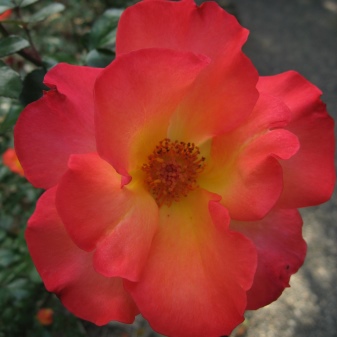
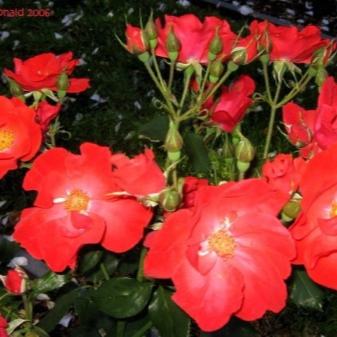
Landing
Roses need open ground and soil well enriched with organic matter. Seedlings can be purchased without roots from November to March. Such planting material is much cheaper than container plants.
If dormant bushes are purchased, then after the purchase, the roots are immediately dipped into a bucket of water. Leave in a humid environment for no more than a day, since a longer stay in such conditions can lead to rotting of the root system. If the rose is not planned to be planted right away, then you can simply moisten a cloth with water and wrap the roots in it.
Before planting, the roots are cut a few centimeters. This procedure may seem wild and terrifying, but it is actually good practice. Such actions stimulate the growth of new roots, especially fibrous ones, which absorb nutrients and moisture from the soil. Thick tree roots serve no purpose other than to anchor the plant in the ground.
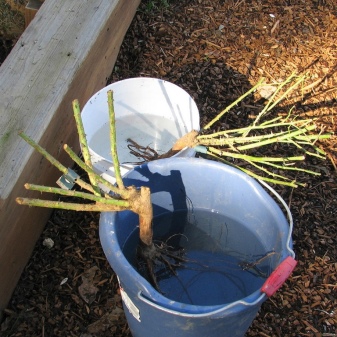
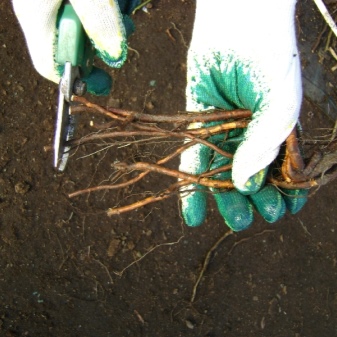
Floribundas should be planted 45-60 cm apart. Before planting, the land is cultivated, a pit is prepared, manure, garden compost or other organic matter are added to the bottom. It is necessary to make the depression quite wide and deep so that the roots completely enter the hole along with the root collar. This is very important, since the point, which is the junction of the roots and the trunk, should not be outside - it is immersed in the ground by 5 centimeters. If this joint is damaged, the plant dies.
The use of fertilizers when planting allows you to provide the rose with the necessary nutrients. The best time for planting is spring: there will be enough time before the fall for the rose to take root.
If the gardener plans to propagate flowers by cuttings, then the planting material is first planted in small containers, where it must take root.The soil is watered abundantly, but it should not be too wet. Cover the top with a film or glass jar, which allows you to create a greenhouse effect.


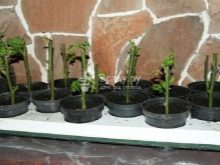
Care
The basic preparation of a flower bed for winter is not only pruning. Sometimes it is necessary to cover the roses so that they do not freeze. Not all varieties require increased attention from the gardener, but there are still some. You can cover it with earth for the winter, that is, dig in, cover it with old foliage, or use old blankets or other material.
In the first spring after planting, the plant is trimmed from the base to three or four buds Is one of the key rules on how to grow healthy roses. In the fall, you will also need to prune roses, since this is one of the mandatory steps for caring for them, however, there are bushes that look great and spreading. Floribunda pruning is best done in the spring, after the risk of frost has passed.
All weak and diseased shoots are removed. Remember that new branches will never be stronger than the ones from which they grow, so be merciless. Novice gardeners need to remember that, unlike hybrid tea varieties, floribundas are grown like bushes. Thus, when pruned almost to ground level, the desired shape of the plant is maintained.


With the beginning of growth, the bushes are fed with fertilizer and continue to do this once a month until the end of July. It can be both multicomponent fertilizers and manure, mineral additives, ammonium or calcium nitrate.
But the care does not end only with fertilizing, sheltering or pruning - it is required to spray the plants in a timely manner, if necessary.
Hygiene is the key to keeping roses healthy and free from the negative effects of pests and diseases. They always remove and destroy all trimmings, and in the fall or at the beginning of winter - fallen leaves, which are the wintering place of some insects.
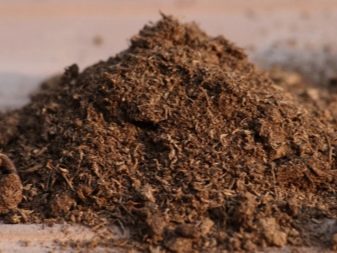
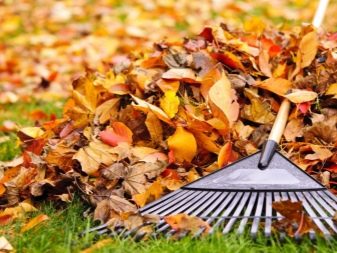
Aphids are always a problem, not only because they feed on sap and weaken plants, but also because they are considered a carrier of certain diseases. Fungal diseases, especially powdery mildew, thrive in confined spaces. That is why it is so important to thin out the bushes and not water them from above - only at the root.
The most versatile remedy is copper sulfate. Its weak solution should be sprayed with plants in early spring. It is prepared only in a plastic or glass container. The concentration can be either 1% or 3%, but not more.
A drug like Funkgineks is great for fighting mold, and a solution of slaked sulfur in lime can be used to remove rust or black spots.
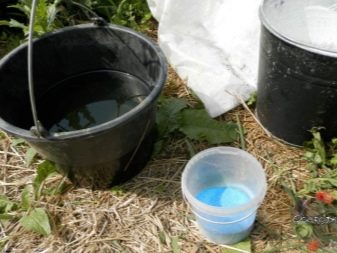

For information on how to grow floribunda roses, see the next video.

































































































The comment was sent successfully.